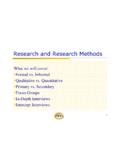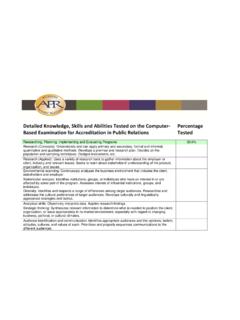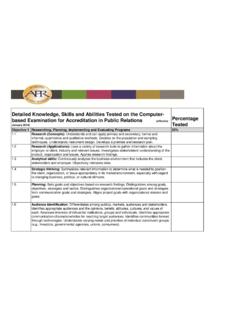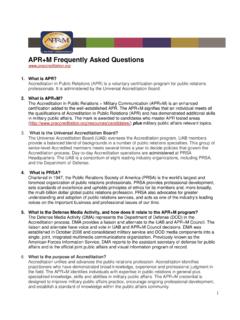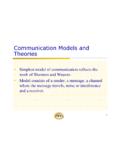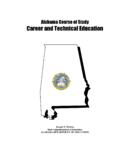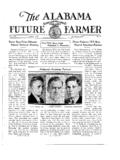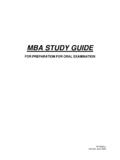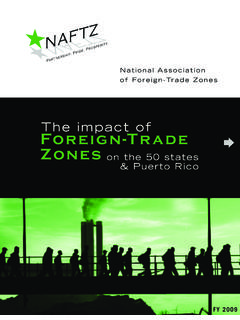Transcription of APR Study Guide - Accreditation in Public Relations
1 APR Study Guide 2017 UNIVERSAL Accreditation BOARD PAGE 1 Study Guide for the Examination for Accreditation in Public Relations A Preparation Tool for Candidates 2017 Universal Accreditation Board Functioning as part of the Public Relations Society of America Fourth Edition APR Study Guide 2017 UNIVERSAL Accreditation BOARD PAGE 2 Acknowledgments The Universal Accreditation Board (UAB) has developed this Study Guide to help candidates prepare for the Examination for Accreditation in Public Relations . The Examination tests broad business and communication knowledge, strategic perspective and sound professional judgment. Successful completion of the Examination, therefore, demonstrates significant knowledge of ethical Public Relations as a management function. The Examination items reflect results of industrywide analyses of Public Relations practice in 2000, 2010 and 2015. This research identified more than 70 areas of competence (knowledge, skills and abilities) that mid-career Public Relations practitioners should demonstrate.
2 Each Examination question has gone through rigorous development, sourcing and pre-testing. A subject-matter expert, trained by a test-development specialist to write test questions, authored each item and tied it to references in the Public Relations body of knowledge. Each question was then edited for readability and clarity by a professional test editor, evaluated by a professional psychometrician and reviewed by a national panel of experts. The Examination continuously evolves as Public Relations practices change and new questions are added. Information in this fourth Study - Guide edition has been compiled, adapted and updated by the Universal Accreditation Examination Preparation Work Group. Organizations participating in the Accreditation process have provided a wealth of resources. Courtesy credits appear in materials that follow. Unless otherwise noted, all approvals for various materials were originally granted to the Public Relations Society of America by authors for the first or second edition of this Study Guide .
3 Feedback on this Study Guide is always welcome. Please send comments to About the Universal Accreditation Board The Universal Accreditation Board, established in 1998, is a credentialing agency for members of 10 Public Relations professional organizations and Public affairs practitioners in the Department of Defense. Each organization contributes resources to the Accreditation process. Senior-level volunteers practitioners, educators and military personnel represent participating organizations on the board and oversee the Accreditation program. That program includes three credentials: Accredited in Public Relations (APR), Accredited in Public Relations and Military Communication (APR+M) and the Certificate in Principles of Public Relations . Participating organizations are the Agricultural Relations Council, Asociaci n de Relacionistas Profesionales de Puerto Rico, California Association of Public Information Officials, Florida Public Relations Association, Maine Public Relations Council, National Association of Government Communicators, National School Public Relations Association, Public Relations Society of America, Religion Communicators Council, Southern Public Relations Federation, and Department of Defense.
4 Editor of the Fourth Edition Douglas F. Cannon, , APR+M, Fellow PRSA, Virginia Polytechnic Institute and State University Members of the 2017 Universal Accreditation Board Examination Preparation Work Group Douglas F. Cannon, , APR+M, Fellow PRSA, Virginia Polytechnic Institute and State University John Forde, , APR, Fellow PRSA, Mississippi State University Lanette Hart, APR, CPRC, Hart and Associates Adam Kelley, APR, Children s of Alabama Elizabeth McMillian, APR, Fiserv APR Study Guide 2017 UNIVERSAL Accreditation BOARD PAGE 3 Contents Acknowledgements .. 2 Contents .. 3 Introduction .. 5 Information and Resources .. 6 Links You Can Use .. 6 Readings .. 6 Tips and What to Expect .. 9 Tips for Preparation .. 9 Tips for the Panel Presentation .. 10 Be Prepared for Questions Panelists May Ask .. 11 What to Expect at the Prometric Testing Center .. 12 Tips for Taking a Computer-Based Examination .. 14 Benefits of Accreditation .
5 15 Public Relations : A Management Function .. 16 What Is Public Relations .. 16 Definitions .. 17 Researching, Planning, Implementing and Evaluating Programs .. 20 The Four-Step Process .. 22 How the Four-Step Process Is Assessed for Accreditation .. 25 Research Methodologies .. 28 Content Analysis .. 33 Survey Research .. 34 Sample Size .. 38 Focus Group Research .. 40 Scientific Method Research .. 43 Writing a Public Relations Plan .. 46 Plan Formats and Styles .. 48 Audience Identification .. 50 The Public Opinion Process .. 52 Diversity .. 56 Definitions .. 59 APR Study Guide 2017 UNIVERSAL Accreditation BOARD PAGE 4 Leading the Public Relations Function .. 63 Business Literacy .. 63 Business Literacy Scavenger Hunt .. 64 SEC Filings .. 70 Business Laws and Regulations .. 71 Types of Employee 74 Resource Managment .. 75 Financial Statements .. 75 Organizing and Structuring .. 76 Problem Solving and Decision Making.
6 76 Leadership and Organizational Skills .. 81 Managing Relationships .. 86 Relationship Building .. 86 Reputation Management .. 89 Internal Stakeholders .. 90 Media Relations .. 91 Networks .. 95 Technology Definitions .. 97 Applying Ethics and Law .. 101 Ethics .. 101 Laws for Public Relations Professionals .. 105 Managing Issues and Crisis Communications .. 108 Issue and Risk Management .. 108 Crisis Management .. 108 Understanding Communication Theories, Models and the History of the Profession .. 112 Theories .. 112 Communication Models .. 120 Eras of Public Relations History .. 125 Figures and Events in Public Relations History .. 128 Case Study and Public Relations Plan Examples .. 129 Case Study : Blue Ridge Water Company .. 129 Case Study : Healthtech Labs .. 133 Case Study : Ramsey Steel .. 145 Plan: Ramsey Steel .. 147 APR Study Guide 2017 UNIVERSAL Accreditation BOARD PAGE 5 Introduction Welcome to the process of becoming Accredited in Public Relations .
7 Preparing for Accreditation is an excellent way to grow professionally. The knowledge, skills and abilities tested on the Examination for Accreditation in Public Relations are building blocks for your career. Your commitment to becoming Accredited is an important decision. Earning APR involves two steps: (1) completing a Panel Presentation and (2) passing a computer-based Examination. The Panel Presentation evaluates your knowledge, skills and abilities in 12 specific areas that cannot be effectively judged in the computer-based Examination. A panel of three Accredited practitioners assesses your competence in creative conceptualization/creativity, initiative, interpersonal skills, management skills, multitasking, flexibility, time management, uses of multiple delivery mechanisms, communication skills/speaking, communication skills/writing and editing, communication skills/listening, and presentation skills. The computer-based Examination tests six groupings of knowledge, skills and abilities (KSAs).
8 The list below indicates the percentage of the Examination devoted to each category. Detailed descriptions of each KSA grouping are given in the following chapters. Researching, Planning, Implementing and Evaluating Programs 33% Leading the Public Relations Function 18% Managing Relationships 15% Applying Ethics and Law 13% Managing Issues and Crisis Communications 13% Understanding Communication Models, Theories and History of the Profession 8% You ll find exercises and case studies throughout this Study Guide . Look for this exercise icon ( ). These exercises should be used with other preparation resources that you choose from the Readings on pp. 6, 7, and 8. This Study Guide should not be your only preparation resource. We recommend that you choose from resources on pp. 6, 7, and 8. In addition, we recommend that you take advantage of coaching sessions offered by participating organizations, mentoring, Study groups, APR Learning Opportunity webinars or workshops, and The Online Study Course.
9 Some resources may fit your individual needs and preparation style better than others. Choose those that work for you. If you need more information, you ll find answers to frequently asked questions on the Universal Accreditation Board website at If you need help, contact your local Accreditation chair, a mentor, a colleague, a friend who recently became Accredited, or Kathy Mulvihill, senior manager, Accreditation Programs, c/o PRSA, 120 Wall Street, 21th Floor, New York, NY 10005, Telephone: (212) 460-1436, APR Study Guide 2017 UNIVERSAL Accreditation BOARD PAGE 6 Information and Resources Links You Can Use Tip: All links in this Study Guide are current as of January 2017. Remember that some websites may change navigation and render links inactive. If you have trouble connecting to a specific page, search from the organization s home page. Candidate s Process for Accreditation in Public Relations What s on the Examination?
10 Demo of Examination for Accreditation in Public Relations Panel Presentation Instructions for Candidates and Panel Presentation Questionnaire APR Online Study Course Readings The Universal Accreditation Board suggests that candidates for Accreditation review contents of at least one general text and one or more of the specialized texts from the Short Bookshelf of Texts below. In some sections of this Study Guide , you will find references to resources not on the recommended bookshelf. These references are intended to encourage you to explore the knowledge, skills and abilities (KSAs) further. Short Bookshelf of Recommended Texts AP Stylebook current edition The Associated Press Stylebook and Briefing on Media Law (current edition). New York: The Associated Press. EPR 11th edition or current Broom, G. M., & Sha, B-L (2013). Cutlip and Center s Effective Public Relations (11th or current edition). Upper Saddle River, : Pearson Education.
